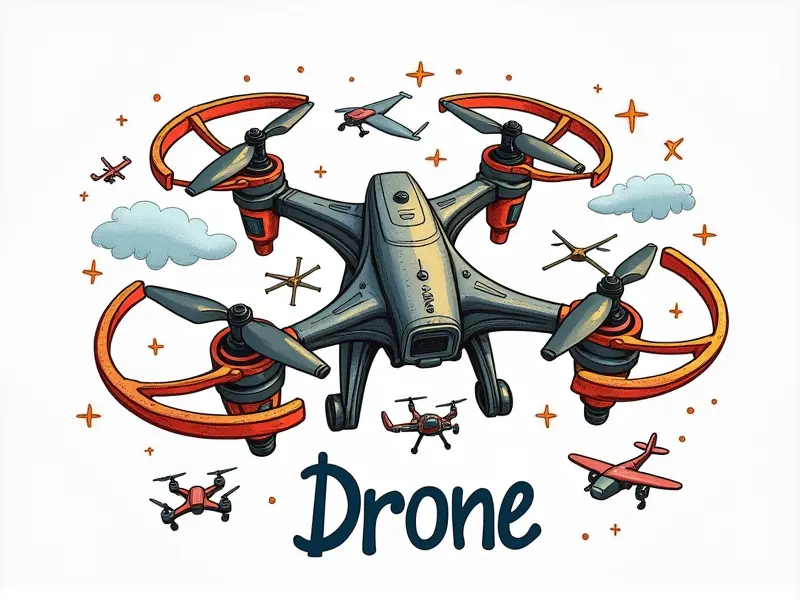How do quadcopters stay up?

Quadcopters, also known as quadrotors or drones, have become increasingly popular in recent years for their versatility and ease of use. These unmanned aerial vehicles (UAVs) are capable of performing a variety of tasks such as aerial photography, videography, surveillance, and more. But how exactly do they stay up in the air? This article delves into the secrets behind quadcopter flight stability and explores the science that makes them possible.
Secrets of Quadcopter Flight Stability
The key to understanding how quadcopters remain airborne lies in their unique design and the principles of aerodynamics. A typical quadcopter consists of four rotors, each with a motor and propeller. The combination of these components allows for precise control over lift and thrust, enabling stable flight.
How Do Quadcopters Hover in Mid-Air?
Hovering is one of the most impressive capabilities of quadcopters. Unlike helicopters that use a single large rotor to generate lift, quadcopters achieve hovering through the coordinated operation of their four rotors. By adjusting the speed and direction of each motor, the drone can maintain its position in mid-air without drifting.
The Science Behind Quadcopter Lift
Understanding how quadcopters generate lift involves delving into the principles of aerodynamics. Each propeller blade acts like an airfoil, creating a pressure difference between the top and bottom surfaces as it rotates. This differential in pressure results in upward force, which is what keeps the drone aloft.
Airfoil Design
The shape of the propellers plays a crucial role in lift generation. The curved upper surface creates lower air pressure compared to the flatter underside, causing air to flow faster over the top and creating an upward force known as lift.
Why Quadcopters Don't Fall from Sky
One of the most intriguing aspects of quadcopter flight is their ability to maintain stability in the sky. This is achieved through a combination of aerodynamic design, electronic sensors, and sophisticated control algorithms. Gyroscopes and accelerometers continuously monitor the drone's orientation and movement.
Sensor Technology
Gyroscopes detect angular velocity around each axis (pitch, roll, yaw), while accelerometers measure linear acceleration along these axes. Together, they provide real-time data to the flight controller about the drone’s attitude and motion.
Understanding Quadcopter Aerodynamics Basics
To fully appreciate how quadcopters stay up in the air, it's essential to grasp some fundamental aerodynamic concepts. These include lift, thrust, drag, and weight (or gravity). The balance between these forces determines whether a drone can ascend, descend, or hover.
Forces Involved
- Lift: Produced by the propellers acting as airfoils.
- Thrust: Generated by the motors to counteract gravity and propel forward.
- Drag: The resistance encountered when moving through the air, which must be overcome for efficient flight.
- Weight (Gravity): Acts downward due to Earth’s gravitational pull.
How Propellers Control Quadcopter Movement
The movement of a quadcopter is finely controlled through the speed and direction of its propellers. By varying the RPMs (revolutions per minute) of individual motors, pilots can manipulate pitch, roll, yaw, and throttle to maneuver the drone in any desired direction.
Propeller Configuration
In a standard quadcopter setup, two propellers spin clockwise (CW), while the other two rotate counterclockwise (CCW). This arrangement ensures balanced torque reactions that keep the drone stable during flight.
Inside the Hovering Mechanism of Drones
The hovering mechanism of a quadcopter relies on precise control over all four rotors. When hovering, the lift generated by each propeller must exactly match the weight of the drone to maintain equilibrium. Any imbalance can cause the drone to drift or descend.
Throttle Control
To hover steadily, pilots adjust the throttle input slightly for small corrections based on real-time sensor data. This fine-tuning ensures that lift remains equal to gravity at all times.
Explaining Quadcopter Aerial Maneuverability
The maneuverability of quadcopters is a testament to their advanced flight control systems and aerodynamic design. By adjusting the speed and direction of propellers, pilots can perform intricate aerial maneuvers with ease.
Movement Control
- Yaw: Rotational movement around the vertical axis for turning.
- Pitch: Tilting forward or backward to ascend/descend vertically.
- Roll: Lateral tilt for horizontal turns and side-to-side movements.
Balancing Act: Quadcopter Flight Dynamics
Maintaining stability during flight requires constant adjustment of the forces generated by each propeller. This balancing act is managed through sophisticated algorithms that process sensor data in real-time, ensuring smooth and stable operation.
Flight Controller Role
The onboard flight controller processes information from sensors to calculate necessary adjustments for each motor. It acts as a central hub coordinating all aspects of drone movement.
Secrets of Quadcopter Lift and Thrust
The generation of lift and thrust in quadcopters hinges on the interaction between propeller design, motor power, and aerodynamic principles. By optimizing these factors, manufacturers can enhance performance and efficiency.
Lift Optimization
Efficient lift production depends on maximizing the difference in air pressure created by each propeller blade. This involves careful selection of materials, blade shape, and rotational speed.
How Gyroscopes Keep Quadcopters Stable
Gyroscopes are critical components that contribute significantly to quadcopter stability. By providing accurate orientation data, they enable the flight controller to make necessary corrections for smooth and stable operation.
Sensor Integration
- Yaw: Rotation about the vertical axis detected by gyroscopes helps maintain heading.
- Pitch/Roll: Changes in tilt are measured to prevent unwanted movements.
In conclusion, quadcopters achieve their remarkable flight capabilities through a blend of aerodynamic design, advanced sensor technology, and precise motor control. By understanding the principles behind lift generation, thrust management, and stability maintenance, we gain insight into why these small marvels can stay aloft with such ease and versatility.

